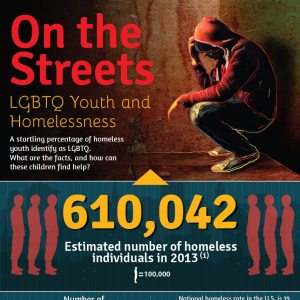On the Streets: LGBTQ Youth and Homelessness
A startling percentage of homeless youth identify as LGBTQ. What are the facts, and how can these children find help?
610,042
Estimated number of homeless individuals in 2013 (1)
46,924
Number of homeless youth (1)
National homeless rate in the U.S. is 19 homeless persons per 10,000 people. (1)
Life as LGBTQ
42%
Percentage of LGBTQ youth who say the community in which they live is not accepting (2)
LGBTQ youth are twice as likely as their peers to say they’ve been physically assaulted at school. (2)
26%
Percentage of LGBTQ youth who say one of their biggest problem is not being accepted by their family (2)
LGBTQ Homelessness
40%
Percentage of homeless youth who are LGBTQ (3)
Top reasons for LGBTQ youth homelessness (3)
Family rejection: 46%
Forced out by parents: 43%
Abuse at home: 32%
Aged out of foster care: 17%
Neglect from family: 14%
Dangers faced by homeless youth (4)
Poor health
Sexual victimization
AIDS/STDs
Mental health issues
Substance abuse
Lack of self-sufficiency skills
No longer able to attend school
Juvenile justice system
58.7%
Percentage of homeless LGBTQ youth who have been sexually victimized. Compare to 33.4% of heterosexual homeless youth. (5)
62%
LGBTQ homeless youth suicide rate. Compare to 29% in heterosexual homeless youth. (5)
Help Is Out There
Breakdown of services (5)
Service: Percentage of clients who are LGBTQ
Drop-in centers: 43%
Street outreach: 30%
Housing programs: 30%
In many states there are shelters and programs that provide helpful services to LGBTQ homeless youth in particular. Here are a few examples. (6, 7, 8, 9)
Ali Forney Center
Where: New York City
What: Youth outreach, drop-in centers with clinics and bathing facilities, and emergency housing.
The Ali Forney Center talks to 500 to 600 youth a month on the streets about their services.
They hold 28 beds for emergency housing and 30 beds of transitional housing where youth are encouraged to work or continue their high school degree.
The Ruth Ellis Center
Where: Detroit and Southeastern Michigan
What: Street outreach, drop-in centers, and transitional housing.
The Ruth Ellis Center served 2,535 youth just last year.
Youth First Resource Center
Where: North Texas
What: Educational programs, STD testing, activities and counseling
Around 15,000 LGBTQ youth live in North Texas.
Los Angeles LGBT Center’s Youth Center on Highland
Where: Los Angeles, CA
What: Meals, clothing, laundry, showers, Internet access, a career center, and support groups for homeless LGBTQ youth.
The Night Ministry’s “The Crib”
Where: Chicago, IL
What: An emergency overnight shelter for homeless young adults in Chicago that offers food and supportive programming.
The Crib has space for 20 youth ages 18 to 24 each night.
Sources:
1. http://b.3cdn.net/
2. http://www.hrc.org
3. http://williamsinstitute.law.ucla.edu
4. https://www.dosomething.org
5. http://nationalhomeless.org
6. http://usich.gov
7. http://www.myresourcecenter.org
8. http://www.lalgbtcenter.org/youth_center
9. http://www.thenightministry.org


